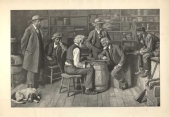The Checker Maven
The World's Most Widely Read Checkers and Draughts Publication
Bob Newell, Editor-in-Chief
Published every Saturday morning in Honolulu, Hawai`i
Noticing missing images? An explanation is here.
The Teacher Gets an "F"

In today's Checker School column we return to Andrew J. Banks' curious and entertaining book, Checker Board Strategy, and our old friends Skittle and Nemo, who are joined by Stone. It's an example of how not to teach checkers. Let's hear the story in Mr. Banks' own words.
"Solve it yourself!" boomed the gray haired State Champion. By his perennial cheerfulness, Skittle had won friends in the Nation's Capital. His mirth was "like a flash of lightning that breaks through the gloom of clouds." He wished to be a "big shot" in Nemo's eyes; therefore, he had asked Champion Stone to teach him how to play expertly. Stone had set up a tough problem. Skittle was baffled.
"Show me how to solve it," he repeated, whereupon Stone roared, "Solve it yourself!"
Was Stone's method wrong? Yes; he failed to show where and why his pupil had failed--- consequently Skittle was crushed. A teacher must adapt his teaching to the ability and temperament of his student. Moreover, he must proceed from the simple to the complex. Do you not agree?
Indeed, hardly the way to encourage a student of the grand old game. The problem in question was a very old one by William Payne. It won't be hard at all for an experienced player but is a good exercise for the student.
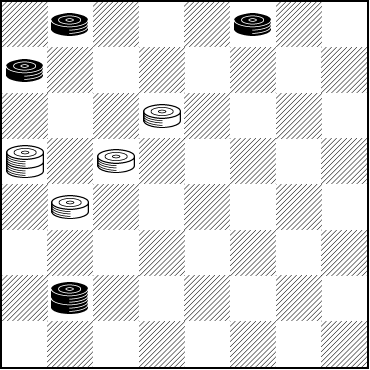
WHITE
White to Play and Win
W:B1,3,5,K25:W10,14,17,K13
We can't really understand why Stone thought this was a hard problem. Be that as it may, an expert will solve it in seconds though a progressing player might take a little longer. We're happy to show you how to solve it; just click on Read More, and we promise that no one will shout at you.![]()
The Weasel

For the first problem of the month we've got one that's very easy and yet very entertaining. When you see the solution you'll understand the title of today's column.
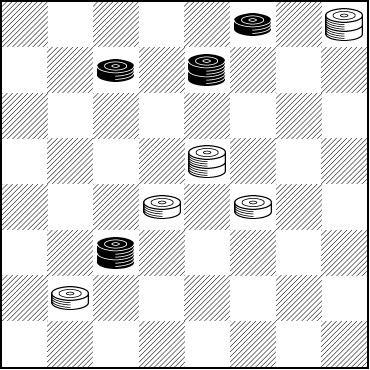
WHITE
White to Play and Win
W:W18,19,25,K4,K15:B3,6,K7,K22
Players beyond beginner level will get this one in a few seconds, and for beginners, the solution will be an amusing discovery.
Don't weasel out; solve the problem and then click on Read More to verify your solution.![]()
Problem Contests Move to Checker Maven

For many years, checker problem legend Bill Salot has been running a series of checker problem composing contests that he calls the "Unofficial World Championship." There have been no less than 55 of these contests and they have seen the publication of a host of quality contemporary compositions, many of which indeed stand in the world-class category.

To date these competitions have been hosted at the American Checker Federation (ACF) website. But over the past few years the ACF website has fallen into a state of neglect, and no longer provides a viable hosting venue. So when Mr. Salot approached us to take over the contest hosting, we happily accepted in the interests of ensuring that these fine competitions would continue into the future as well as reach a wider audience.

Today we proudly host Contest 56 and you'll have not one but three sparkling problems to contemplate. You can access the competitions, now and in the future, at
Mr. Salot asks that you be sure to vote for your choice of winner after you've studied all the problems. More information is available on the contest page.

Please enjoy this new Checker Maven feature, brought to you by Bill Salot and some of the best contemporary checker problemists.![]()
Brian's Prize Problem

Prize increased to $100!
In checkers we think of a "prize problem" as one that is so good it has won a prize of some sort, presumably in a problem composing contest. But today we have a prize problem that gives a prize rather than wins one--- although we think it's more than good enough to take the prize in many a contest.

Brian Hinkle offers $25 to the reader who is the first to correctly solve the following problem.
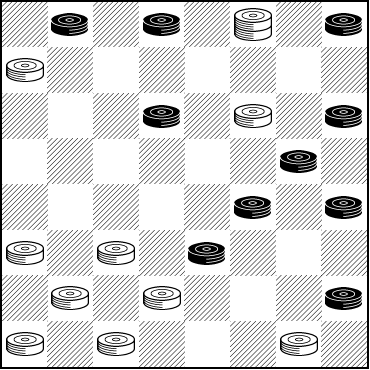
WHITE
White to Play and Win
W:WK3,5,11,21,22,25,26,29,30,32:B1,2,4,10,12,16,19,20,23,28
Is it difficult? You bet it is, and it will require much skill and board vision to work it out. Go ahead, give it your best. Set it up and move the pieces around.
We'll publish the solution on June 5 (Note: this has been delayed due to the increased prizes) and announce the winner (if there is one, and if the winner agrees to have his or her name and location published). The prize won't be awarded if no one solves the problem correctly.
Brian also asks you to help give a name to this problem. He's called it simply "Prize Problem" but wonders if there is a title that might be more thematic. Send your solutions and name ideas to Brian by emailing sbhinkle@charter.net.
Unfortunately in today's legal environment there are some additional terms and conditions. Please read them carefully.
Void where prohibited by law. Taxes, if any, are the responsibility of the winner. The composer, Brian Hinkle, is the sole judge of the correctness of submitted solutions and his decisions are final and without appeal. All correspondence and solution attempts must be sent to sbhinkle@charter.net. Do not send solutions or questions to The Checker Maven. All solutions and suggested problem names become the property of Brian Hinkle and The Checker Maven. If you submit a solution or correspond with Brian, you understand and agree that Brian will then have your email address and possibly your name. To receive the prize, the winner must provide Brian with a postal mailing address. Brian pledges that email and postal addresses will be used only for the purposes of the contest and will not be disclosed to any third party unless a legal obligation to do so arises.
Good luck to one and all!![]()
Rebound

Rebound. With the literal meaning of "bouncing back" the term applies to a number of things. There's the rebound in basketball. Someone recovering from an injury or illness can be said to be "on the rebound." And of course there's always the "rebound romance."
"Rebound" is an apt title for today's Checker School column. You'll see why when you solve it.
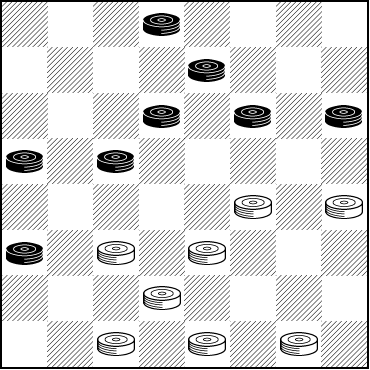
WHITE
White to Play and Win
W:W19,20,22,23,26,30,31,32:B2,7,10,11,12,13,14,21
This one is probably around medium in difficulty. You may not get it on the first try, but we're sure you'll "rebound" from any such small setbacks and find the solution. When you've either figured it out or bounced around enough, click on Read More to bound over all barriers and see how it's done.![]()
Easy April

April. For much of North America, winter is coming to an end. There's more daylight. Compared to the winter months, it's an easy month. Well, mostly. In both the US and Canada, income tax returns come due. Kind of spoils the "easy" theme, doesn't it?
On the checker front, though, we'd like to ease into April, even if April isn't completely easy. Here's a speed problem sent to us by regular contributors Lloyd and Josh Gordon of Toronto. It's very much on the easy side. An experienced player will solve it in a few seconds; a beginner might take a little longer, but not a lot. At the Checker Maven we try to provide something for everyone.
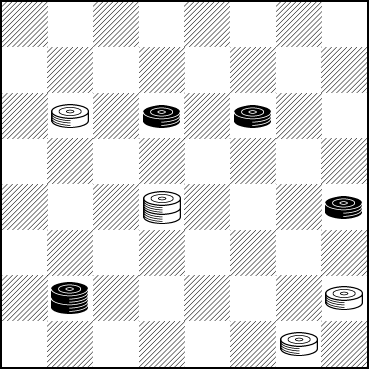
WHITE
White to Play and Win
W:W32,28,9,K18:B20,11,10,K25
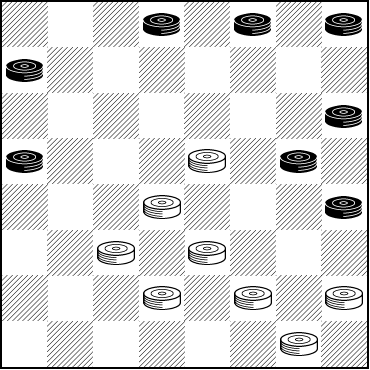
WHITE
White to Play and Win
W:W15,18,22,23,26,27,28,32:B2,3,4,5,12,13,16,20
Black has just played 1-5, whereas 1-6 or a couple of other moves would have held a narrow draw. Yes, this certainly looks like a White win, but it's a good exercise in application of technique to work out how it's done. Not nearly as easy as our first problem, but straightforward enough.
An easy start to April, or a harder one? You be the judge. Solve the problems and then it's easy enough to click on Read More to check your solutions.![]()
Jumpin' Jehoshaphat
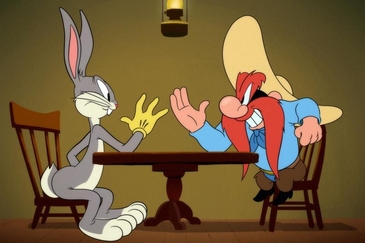
Yosemite Sam, the arch-enemy of Bugs Bunny, is famously known to exclaim, "Jumpin' Jehoshaphat!" but it's not likely that the said toon character was aware of the origins of this expression.
Indeed, there isn't a lot known about the phrase, except that it first appeared in print in 1866 and is thought to be part of the 19th century predilection for "minced oaths" which embodied a strong expression of feeling without actually using potentially offensive words. Other efforts to relate the expression to the biblical Jehoshaphat seem to us to be somewhat forced.
In today's Checker School column, taken from Andrew J. Banks' unusual and instructive book, Checker Board Strategy, we meet a "Jumpin' Jehoshaphat" checker problem. You'll see what we mean when you solve it.
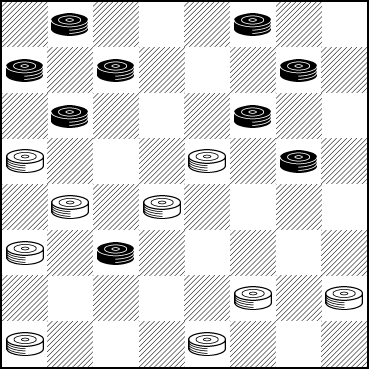
WHITE
White to Play and Win
W:W13,15,17,18,21,27,28,29,31:B1,3,5,6,8,9,11,16,22
Jump to it! Solve the problem and then jump your mouse over to Read More to verify your solution.![]()
Relatively Easy; A Speed Problem
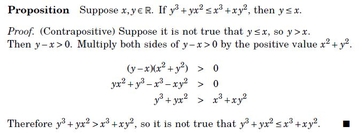
What's easy for some isn't quite so easy for others. The math above is quite simple if you happen to be a Ph.D. mathematician. If you struggle with high school algebra, you may not find it all that easy.
Regular contributors Lloyd and Josh Gordon sent us a checker problem which illustrates this concept rather well. Take a look at the diagram below.
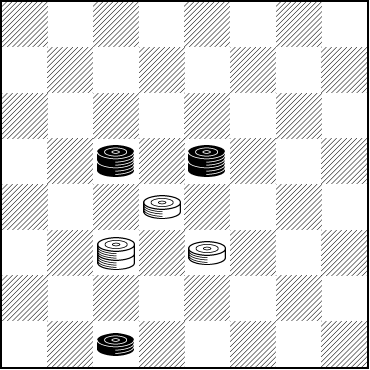
BLACK
Black to Play and Win
B:W10,K11,15:B3,K18,K19
Is this problem easy? For a player with a little experience, it's pretty straightforward. For a novice, it might be harder and take a little more effort. While we're calling it a "speed problem" we won't specify a time limit. Solve it as quickly as you can.
What's easy for anyone, though, is clicking on Read More to see the solution.
[Read More]Cute and Tricky

We think the title photo speaks for itself. This cute little one certainly seems to be up to something.
Today we have not one but two speed problems. The first one is very easy but quite cute.
WHITE

BLACK
Black to Play and Win
B:WK3,20,24,30:B12,15,22,K27
The second problem is a bit harder, but not much.
BLACK

WHITE
White to Play and Draw
W:WK10,20:B8,12,K19
This problem could just as well have had the terms White to Play, Black to Draw. It's not at all difficult but it has a nice tricky little twist. You'll see what we mean when you solve it.
Are you tricky enough to solve a cute problem? (We won't ask you the implied inverted question.) When you've found the solutions, click on Read More to verify your solutions.![]()
Dangling

Our heroine above is dangling above --- well, we don't know what. A bottomless ravine? A pit filled with rattlesnakes? A fiery inferno? We can only hope that she finds a way to safety.
Similar situations come up in the game of checkers. Sometimes, a piece is dangling and can't be rescued. Or it might suffer a different fate, or something else altogether.
There's a point to all this. Today's Checker School entry is a very old problem from Joshua Sturges. It isn't especially hard; indeed, it's just about a ten second speed problem. But it's very instructive and rather neat. After you've solved it, you may see why this column has the title that it does, and that "dangling" can have an alternative meaning.
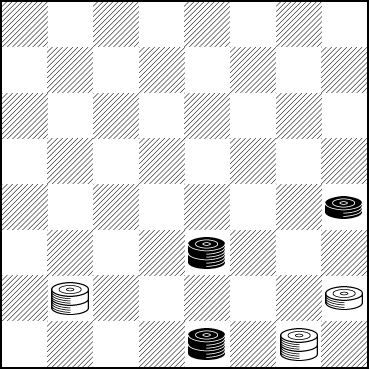
WHITE
White to Play and Win
W:WK25,K32,28:BK31,K23,20
The problem is found (among many other places) in the "Problems for Beginners" section of Andrew J. Banks' Checker Board Strategy. We're not sure if a complete beginner could solve it, but it's within reach of anyone above novice level.
Don't let the solution dangle; find it and click on Read More to verify your answer.![]()
The Checker Maven is produced at editorial offices in Honolulu, Hawai`i, as a completely non-commercial public service from which no profit is obtained or sought. Original material is Copyright © 2004-2025 Avi Gobbler Publishing. Other material is public domain, as attributed, or licensed under Creative Commons. Information presented on this site is offered as-is, at no cost, and bears no express or implied warranty as to accuracy or usability. You agree that you use such information entirely at your own risk. No liabilities of any kind under any legal theory whatsoever are accepted. The Checker Maven is dedicated to the memory of Mr. Bob Newell, Sr.

